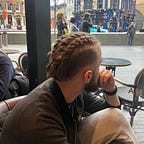25. Poverty and mental diseases’ vicious circle and how police officers’ race affects interactions with civilians.
It is perhaps expected that low socioeconomic status can lead to poor mental health. When one has to worry not only about their goals and general health, but also the most basic human needs, the pressure on their mind is constant. The reverse link, while not as obvious, is also somewhat predictable. Poor mental health can impact decision making, as well as affect productivity and lead to worse work outcomes. This creates an easy spiral for individuals to fall into, so what could we do to help?
Poverty, depression, and anxiety: Causal evidence and mechanisms — easy read. Ridley et al.examine the processes through which mental health affects socioeconomic status and vice versa. While the commonly held belief is that depression or anxiety are diseases of affluence (aka “rich people problems”,) research shows quite the opposite. People with lowest incomes are 1.5 to 3 times more likely to suffer from either of these, essentially leading them to living with disability (another common misconception is that depression or anxiety is not considered a disability, which should be discussed separately.) To make matters worse, poorer countries usually spend proportionately much less on mental healthcare compared to physical one, and hence even though low-cost treatments exist, about 80% of mental health issues around the world go untreated. And, in contrast to vast majority of physical health issues, depression or anxiety directly affect people’s financial and other life decisions, often perpetuating poverty. The authors provide a solid introduction to the many moving parts of this issue, and then present us with numbers that are pretty clear: even one-time interventions can break this cycle and help people in a meaningful way. For example, data from Indonesia shows that, on average, suicide rates in subdistricts that received government cash transfers in first instalment dropped by 18% compared to subdistricts that received help later. Moreover, the transfers appear to uplift people in dire situation even more, with suicide rates dropping twice as much in districts affected by flooding, compared to those not facing this challenge. There is a lot to learn and understand from reading this paper alone, and I consider it an important text for anybody interested in making the world a better place through supporting people. The text is paywalled, but a preprint is available on MIT servers.
As the last and current year are painfully reminding us of something communities of color experience every day, our skin may dramatically affect the outcome of an encounter with police officers. While the issue is more global than it appears (which deserves a separate read,) in the USA, it painfully prolongs the history of inequity reaching back to the earliest days of the country. Black people are approached, arrested, have force used against them or get killed disproportionately more often than whites. One of the most common suggestions for improving this situation is deepening racial and gender diversity in the police force. Recent research from Science investigates exactly that.
The role of officer race and gender in police-civilian interactions in Chicago — medium-easy read. Ba et al. did a case-study based on very rich data of police officers interactions with the public in Chicago, city with history of tensions with the police. While the data may be very localized, causing some limitations to the universality of the results, the data from Chicago Police Department is surprisingly rich, enabling for proper comparison of general statistics on stops, arrests and use of force by police officers across the city, while taking into account the circumstances. Authors provide a lengthy introduction into problems with research up to date, including the necessity to compare not just raw numbers, but also the situations in which certain decisions were made. The neighborhood, time of day or recent context may all affect the situation on the ground, and leading to skewed statistics if not taken into account. Researchers have carefully trimmed the data to enable meaningful comparison, and share the numbers with us indicating clearly: relative to white officers, Black and Hispanic officers make far fewer stops and arrests, and they use force less often, especially against Black civilians. These enforcement disparities are mainly related to relatively minor crimes, not violent offences, suggesting little trade-off in terms of public safety. For example, Black officers make 31% less stops for “suspicious behavior” compared to white officers. Similarly, female police officers use force more rarely than males. In general, while we have to get data from other parts of America to draw more general conclusions, the data strongly indicates that indeed diversity reforms can lead to substantial improvements in treatment of minorities by the police. Also this article is paywalled, but it is also available on one of the authors’ website on Princeton servers.
